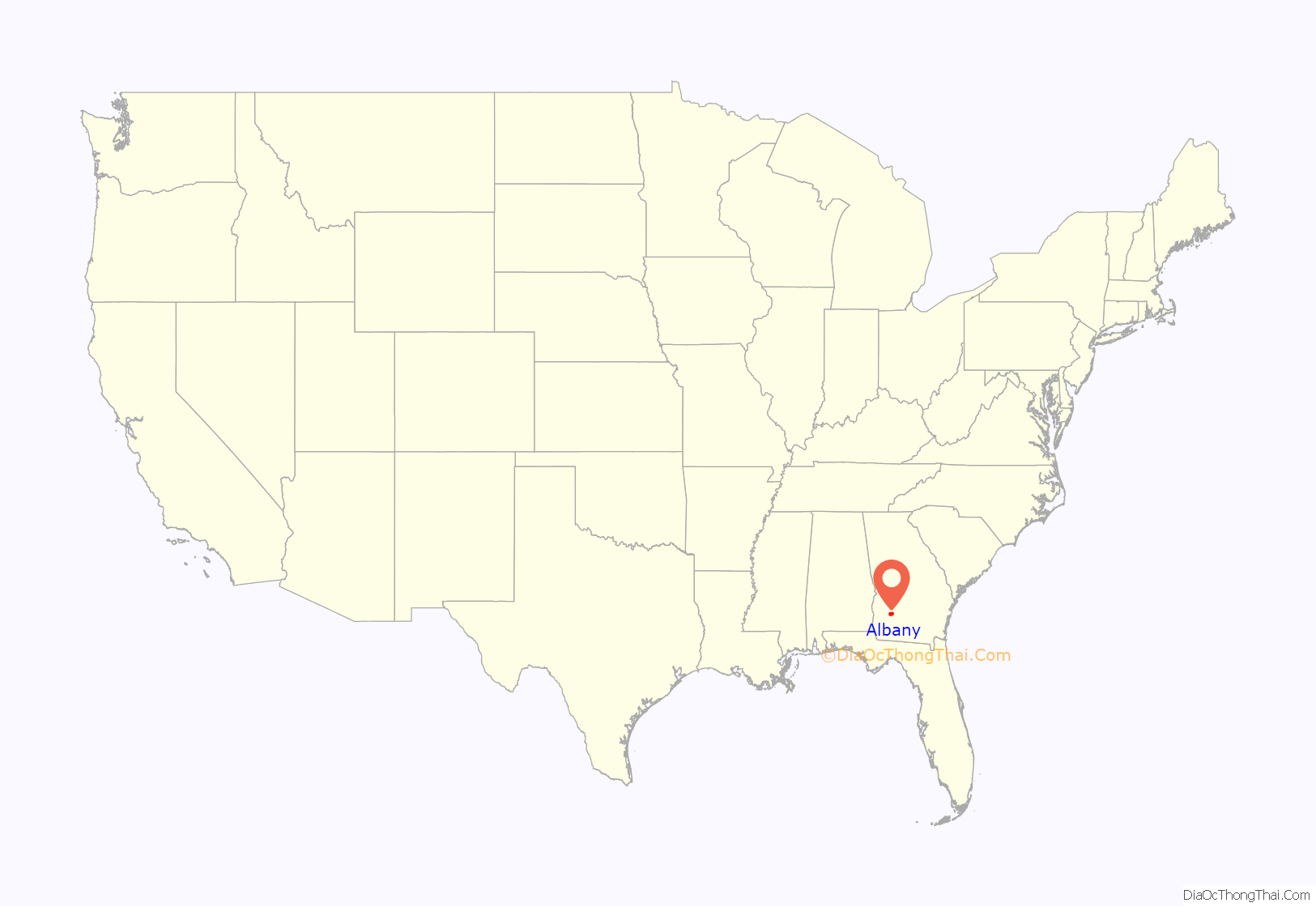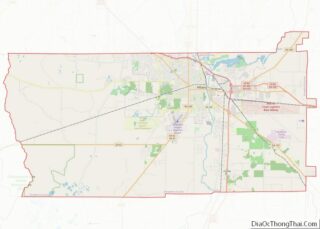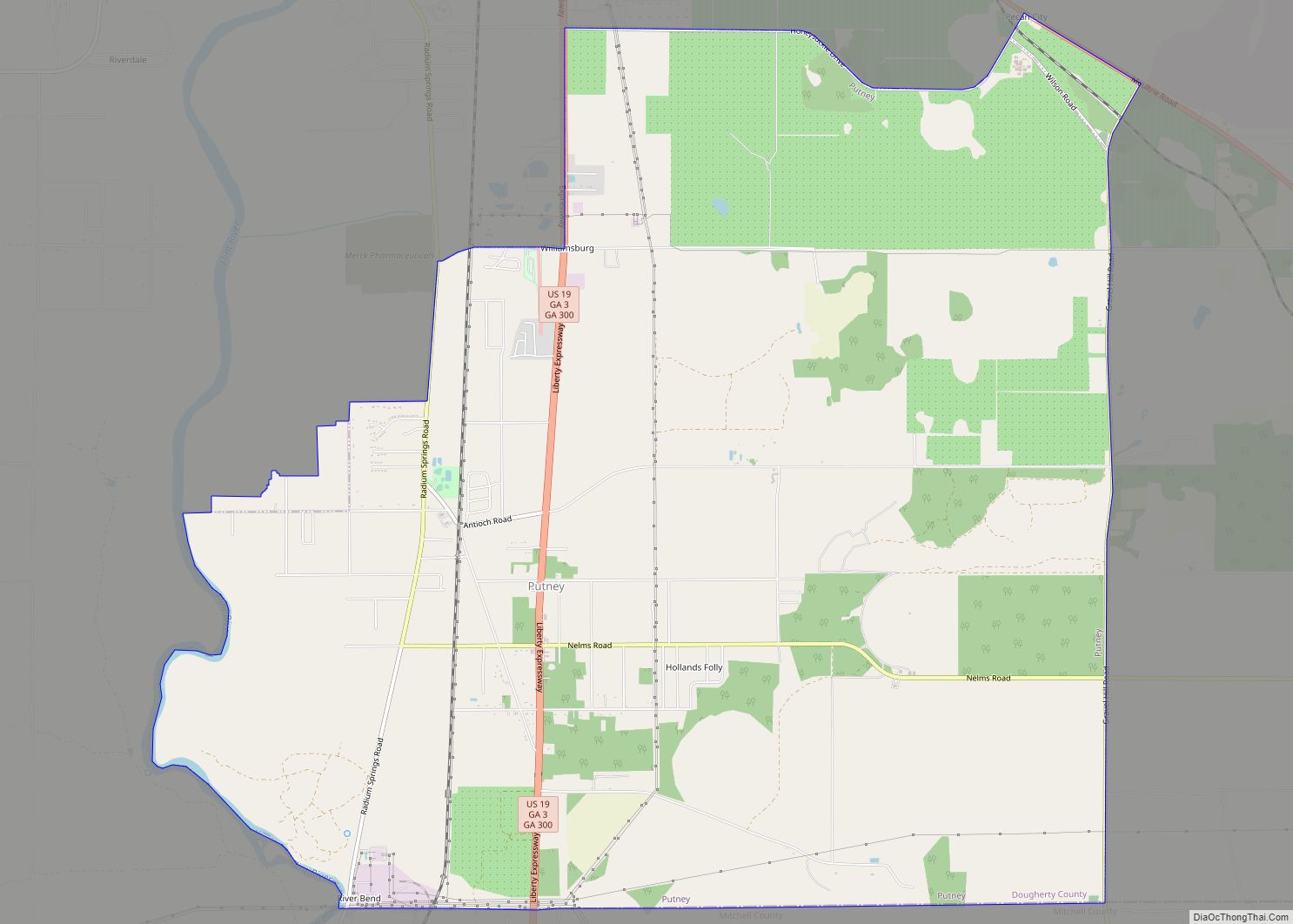Albany (/ˈɔːlbəni/ AWL-bə-nee) is a city in the U.S. state of Georgia. Located on the Flint River, it is the seat of Dougherty County, and is the sole incorporated city in that county. Located in southwest Georgia, it is the principal city of the Albany, Georgia metropolitan area. The population was 77,434 at the 2010 U.S. Census, making it the eighth-largest city in the state. It became prominent in the nineteenth century as a shipping and market center, first served by riverboats. Scheduled steamboats connected Albany with the busy port of Apalachicola, Florida. They were replaced by railroads. Seven lines met in Albany, and it was a center of trade in the Southeast. It is part of the Black Belt, the extensive area in the Deep South of cotton plantations. From the mid-20th century, it received military investment during World War II and after, that helped develop the region. Albany and this area were prominent during the civil rights era, particularly during the early 1960s as activists worked to regain voting and other civil rights. Railroad restructuring and reduction in the military here caused job losses, but the city has developed new businesses.
| Name: | Albany city |
|---|---|
| LSAD Code: | 25 |
| LSAD Description: | city (suffix) |
| State: | Georgia |
| County: | Dougherty County |
| Elevation: | 203 ft (62 m) |
| Land Area: | 55.06 sq mi (142.62 km²) |
| Water Area: | 0.76 sq mi (1.98 km²) |
| Population Density: | 1,264.84/sq mi (488.35/km²) |
| Area code: | 229 |
| FIPS code: | 1301052 |
| GNISfeature ID: | 0310424 |
| Website: | www.albanyga.gov |
Online Interactive Map
Click on ![]() to view map in "full screen" mode.
to view map in "full screen" mode.
Albany location map. Where is Albany city?
History
Albany is located in a region which was long inhabited by the Creek Indians, who called it Thronateeska after their word for “flint”, the valuable mineral found in beds near the Flint River. They used it for making arrowheads and other tools. In 1830 Congress passed the Indian Removal Act, and the United States made treaties to extinguish Creek and other Native American land claims in the Southeast. The US Army forcibly removed most of the native peoples to Indian Territory, lands west of the Mississippi River.
Nelson Tift
European-American settlement began with Nelson Tift of Groton, Connecticut, who took land along the Flint River in October 1836 after Indian removal. Tift and his colleagues named the new town Albany after the capital of New York; noting that New York’s Albany was a commercial center located at the headwaters of the Hudson River, they hoped that their town near the headwaters of the Flint would prove to be just as successful. It proved to be nowhere near as prosperous. Alexander Shotwell laid out the town in 1836, and it was incorporated as a city by an act of the General Assembly of Georgia on December 27, 1838.
Tift was the city’s leading entrepreneur for decades. An ardent booster, he promoted education, business, and railroad construction. During the Civil War he provided naval supplies and helped build two ships. He opposed Radical Reconstruction inside the state and in Congress, and was scornful of the Yankee carpetbaggers who came in. Historian John Fair concludes that Tift became “more Southern than many natives.” His pro-slavery attitudes before the war and his support for segregation afterward made him compatible with Georgia’s white elite.
This area was developed for cotton cultivation by planters, who used numerous enslaved African Americans to clear lands and process the cotton. As a result of the planters’ acquisition of slave workers, by 1840 Dougherty County’s majority population was black, composed overwhelmingly of slaves. The market center for cotton plantations, Albany was in a prime location for shipping cotton to other markets by steamboats. In 1858, Tift hired Horace King, a former slave and bridge builder, to construct a toll bridge over the river. King’s bridge toll house still stands.
Already important as a shipping port, Albany later became an important railroad hub in southwestern Georgia. Seven lines were constructed to the town. An exhibit on trains is located at the Thronateeska Heritage Center in the former railroad station.
Carey Wentworth Styles
After the war, Carey Wentworth Styles moved to Albany and founded the newspaper Albany News. In the early years following the war, Styles, like Tift, took great exception to the Radical Reconstruction program then in force, and advocated for a more moderate response based on his interpretation of Georgia’s rights under the Constitution. Styles backed “constitutional reconstruction” advanced by Benjamin H. Hill and sought support for the idea from the national Democratic party. While on a trip to Atlanta in May 1868, to meet with Democratic party leaders, Styles took measure of the contemporary Atlanta newspapers, and found them lacking. Styles believed them to be little more than organs for the Radical Republican reconstruction agenda. He resolved to bring a paper aligned with the Democratic party viewpoint to the Atlanta market, one supporting his constitutional reconstruction ideals. Styles moved from Albany to Atlanta, and on May 9 he announced that he had obtained the necessary financial backing to purchase the Daily Opinion. On June 16, 1868 the new Democratic daily (as he described it) printed its first edition, under the name The Constitution. Styles’ tenure at the Atlanta Constitution would be brief. Unable to pay for his portion of the purchase, when the sale of his Albany News fell through, Styles was forced to surrender his interest in the paper to his joint venture partners. Styles returned to Albany as editor of the News. In 1872, he was elected to the Georgia Senate, representing Augusta and surrounding communities, in an ironic turn of events, having killed a member of the Georgia House of Representatives in his earlier years. After his legislative service, Styles sold the Albany newspaper in 1876 and returned to Atlanta.
20th century to present
While integral to the economic life of the town, the Flint River has flooded regularly. It caused extensive property damage in 1841 and 1925. The city has also been subject to tornadoes. On February 10, 1940, a severe tornado hit Albany, killing eighteen people and causing large-scale damage.
On April 11, 1906, the Carnegie Library, created by matching funds from the philanthropist Andrew Carnegie, was opened downtown. Originally a segregated facility under Jim Crow laws, it was not open to African Americans until after the passage of the Civil Rights Act of 1964. It functioned as a library through 1985. In 1992, after renovation, the building was reopened as the headquarters of the Albany Area Arts Council.
In 1912, the downtown U.S. Post Office and courthouse building opened. Other federal projects have been important to the city and region. In 1937, Chehaw Park was constructed as a part of a New Deal program under the administration of President Franklin D. Roosevelt during the Great Depression.
Major changes came with the expansion of military facilities in the city, secured by the powerful Southern Block in Congress. A U.S. Army Air Corps training base was built near Albany on land owned by the city and leased to the Air Corps for $1 a year. Construction of the base and airfield by the Army Corps of Engineers began on March 25, 1941. After being used during World War II, the airfield was temporarily deactivated between August 15, 1946, and September 1, 1947.
After the beginning of the Cold War and the founding of the U.S. Air Force in late 1947, the airfield was reactivated and upgraded with runways for a U.S. Air Force base. It was named Turner Air Force Base. The Air Force used this base for heavy bomber jets, such as the B-52 Stratofortress. A number of other Air Force units were also housed at this base. Among them were the 1370th Photomapping Group, and refueling and maintenance functions.
In 1951, the U.S. Marine Corps established a logistics base on the eastern outskirts of Albany. During the 1950s and 1960s, so many white servicemen and associated workers arrived that the city briefly became majority white for the first time since 1870.
In 1960, the population of Albany reached 50,000 people. During 1961–1962, African Americans in Albany played a prominent role in the Civil Rights Movement (see the Albany Movement). They led protests and non-violent demonstrations to end segregation of public facilities, gain the right to vote, and advance social justice. Assisted by activists from SCLC, CORE, SNCC, and the NAACP, African Americans and supporters took a stand to fight segregation through nonviolence. The city repealed its Jim Crow laws in 1963, but African Americans did not recover the ability to exercise their voting rights until Congress passed enforcement authority with the Voting Rights Act of 1965.
In 1967, the Air Force closed all its operations at the base, which was transferred to the U.S. Navy and renamed Naval Air Station Albany. NAS Albany was used as the shore base of nearly all the Navy’s RA-5C Vigilante twin-jet, carrier-based reconnaissance aircraft. In 1974, the base was closed and the property was returned to the city.
In 1979, the Miller Brewing Company purchased part of the old naval base’s property to build a new brewery.
The decline in military bases and railroad restructuring nationwide both led to job losses in the Albany area. Much of the remaining white population moved to suburbs and newer housing out of the city, which became majority African American in the 1970s. Struggling with a poor economy, in 1988 Albany made national headlines as the “Murder Capital of America,” with the highest murder rate per capita in the United States. Other cities have since taken that title.
Some late twentieth-century floods have been extreme. In 1994, a severe flood was caused by rainfall from Tropical Storm Alberto; it killed 14 people and displaced 22,000. The state supported a $150 million renovation of the Albany State University campus to repair storm damage and complete upgrades. New housing was built on the south side of town to replace what had been destroyed. In 1998, the Flint River crested at 35 feet (11 m) above its bed and flooded parts of the city.
Because of such flooding, the city has decided against redeveloping areas along the riverfront floodplain for commercial or residential purposes. This area is being improved for other uses, with a riverfront walkway and a new aquarium built over a tributary creek.
On January 2 and 22, 2017, violent tornadoes passed through the area, claiming several lives and destroying mobile home parks in the process. On October 10, 2018 Hurricane Michael, the first major hurricane (Category 3+) to directly impact Georgia since the 1890s, plowed through South Georgia leaving widespread devastation in its path.
Albany Road Map
Albany city Satellite Map
Geography
Albany is located at (31.582273, −84.165557). It lies in a belt of historically rich farmland in the East Gulf coastal plain, on the banks of the Flint River.
Topography
Albany lies in the Upper Coastal Plain of Georgia.
Location
Albany is located in southwestern Georgia, 78 mi (126 km) southeast of Columbus, 151 mi (243 km) south of Atlanta, 45 mi (72 km) south of Americus, 93 mi (150 km) southwest of Macon, 39 mi (63 km) west of Tifton, 73 mi (117 km) northwest of Valdosta, 88 mi (142 km) north of Tallahassee, Florida, 70 mi (110 km) east of Eufaula, Alabama, and 84 mi (135 km) east of Dothan, Alabama.
Tree canopy
As of 2010, the City of Albany had been a member of the Arbor Day Foundation’s Tree City USA Program for 23 years. Tree-lined streets are common, with large, mature oaks and other native trees. The city has a Tree Ordinance and a certified arborist on staff.
Parks, gardens, and trails
The City of Albany Government’s Recreation and Parks Department provides a diverse and comprehensive system of 77 park facilities throughout the City of Albany.
Albany’s Garden Club was established in 1996 and is located on the northeast side of Hillsman Park in the Palmyra Heights neighborhood.
Albany’s Riverfront Trail is a 3.1-mile (5.0 km) paved trail along the Flint River that connects Riverfront Park in downtown Albany to the Cox Landing Boat Ramp in northeast Albany, near Chehaw Park. The Oxford Environmental Park Nature Trail is an offshoot of the trail, which provides information about the ecological features of the area.
Albany Mall, the premier shopping center in the region, opened in 1976.
See also
Map of Georgia State and its subdivision:- Appling
- Atkinson
- Bacon
- Baker
- Baldwin
- Banks
- Barrow
- Bartow
- Ben Hill
- Berrien
- Bibb
- Bleckley
- Brantley
- Brooks
- Bryan
- Bulloch
- Burke
- Butts
- Calhoun
- Camden
- Candler
- Carroll
- Catoosa
- Charlton
- Chatham
- Chattahoochee
- Chattooga
- Cherokee
- Clarke
- Clay
- Clayton
- Clinch
- Cobb
- Coffee
- Colquitt
- Columbia
- Cook
- Coweta
- Crawford
- Crisp
- Dade
- Dawson
- Decatur
- DeKalb
- Dodge
- Dooly
- Dougherty
- Douglas
- Early
- Echols
- Effingham
- Elbert
- Emanuel
- Evans
- Fannin
- Fayette
- Floyd
- Forsyth
- Franklin
- Fulton
- Gilmer
- Glascock
- Glynn
- Gordon
- Grady
- Greene
- Gwinnett
- Habersham
- Hall
- Hancock
- Haralson
- Harris
- Hart
- Heard
- Henry
- Houston
- Irwin
- Jackson
- Jasper
- Jeff Davis
- Jefferson
- Jenkins
- Johnson
- Jones
- Lamar
- Lanier
- Laurens
- Lee
- Liberty
- Lincoln
- Long
- Lowndes
- Lumpkin
- Macon
- Madison
- Marion
- McDuffie
- McIntosh
- Meriwether
- Miller
- Mitchell
- Monroe
- Montgomery
- Morgan
- Murray
- Muscogee
- Newton
- Oconee
- Oglethorpe
- Paulding
- Peach
- Pickens
- Pierce
- Pike
- Polk
- Pulaski
- Putnam
- Quitman
- Rabun
- Randolph
- Richmond
- Rockdale
- Schley
- Screven
- Seminole
- Spalding
- Stephens
- Stewart
- Sumter
- Talbot
- Taliaferro
- Tattnall
- Taylor
- Telfair
- Terrell
- Thomas
- Tift
- Toombs
- Towns
- Treutlen
- Troup
- Turner
- Twiggs
- Union
- Upson
- Walker
- Walton
- Ware
- Warren
- Washington
- Wayne
- Webster
- Wheeler
- White
- Whitfield
- Wilcox
- Wilkes
- Wilkinson
- Worth
- Alabama
- Alaska
- Arizona
- Arkansas
- California
- Colorado
- Connecticut
- Delaware
- District of Columbia
- Florida
- Georgia
- Hawaii
- Idaho
- Illinois
- Indiana
- Iowa
- Kansas
- Kentucky
- Louisiana
- Maine
- Maryland
- Massachusetts
- Michigan
- Minnesota
- Mississippi
- Missouri
- Montana
- Nebraska
- Nevada
- New Hampshire
- New Jersey
- New Mexico
- New York
- North Carolina
- North Dakota
- Ohio
- Oklahoma
- Oregon
- Pennsylvania
- Rhode Island
- South Carolina
- South Dakota
- Tennessee
- Texas
- Utah
- Vermont
- Virginia
- Washington
- West Virginia
- Wisconsin
- Wyoming






